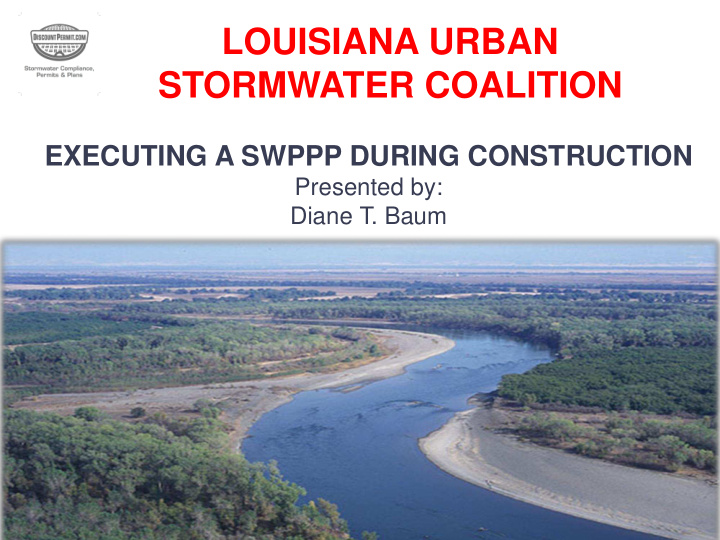



LOUISIANA URBAN STORMWATER COALITION EXECUTING A SWPPP DURING CONSTRUCTION Presented by: Diane T. Baum
SWPPP NOTIFICATION SIGN Post sign at entrance of site or areas where the public can easily access. Identify inspector and contact numbers. Prefer contacting SWPPP inspector than municipality or DEQ. Nov 2012
OVERVIEW : SECTIONS OF A SWPPP SECTION 1: SITE EVALUATION, ASSESSMENT & PLANNING SECTION 2: EROSION AND SEDIMENT CONTROL BMPS SECTION 3: GOOD HOUSEKEEPING BMPS SECTION 4: SELECTING POST-CONSTRUCTION BMPs SECTION 5: INSPECTIONS SECTION 6: RECORDKEEPING AND TRAINING SECTION 7: FINAL STABILIZATION SECTION 8: CERTIFICATION AND NOTIFICATION SWPPP APPENDICES Nov 2012
EROSION CONTROL Minimizing the Impact of Construction: 1. Minimize disturbed area and protect natural features and soil 2. Phase construction activity 3. Control stormwater flowing onto and through the project 4. Stabilize soils promptly 5. Protect slopes Sediment Controls (the second line of defense): 6. Protect storm drain inlets 7. Establish perimeter controls 8. Retain sediment on-site and control dewatering practices 9. Establish stabilized construction exits 10. Inspect and maintain controls September 21 - 22, 2011
WHAT IS STABILIZATION IN A SWPPP? EPA’s Construction General Permit : “ stabilization measures must be initiated as soon as practicable in portions of the site where construction activities have temporarily or permanently ceased, but in no case more than 14 days after the construction activity in that portion of the site has temporarily or permanently ceased.” Nov 2012
WASTE MANAGEMENT Provide for waste management. Design proper management procedures and practices to prevent or reduce the discharge of pollutants to stormwater from solid or liquid wastes that will be generated at your site. Practices such as trash disposal, recycling, proper material handling, and cleanup measures can reduce the potential for stormwater runoff to pick up construction site wastes and discharge them to surface waters. Determine if your site is following LEED requirements. Nov 2012
NON-STORMWATER DISCHARGES Non-stormwater discharges that are allowable should be identified: • Discharges from fire-fighting activities, Fire hydrant flushings Waters used to wash vehicles where detergents are not used • Water used to control dust in accordance with EPA’s CGP, Part 3, Subpart 3.4.G • • Potable water including uncontaminated water line flushing Routine external building wash down that does not use detergents • • Pavement wash waters where spills or leaks of toxic or hazardous materials have not occurred (unless all spilled material has been removed) and where detergents are not used Uncontaminated air conditioning or compressor condensate • Uncontaminated ground water or spring water • • Foundation or footing drains where flows are not contaminated with process materials such as solvents Uncontaminated excavation dewatering • Landscape irrigation • Nov 2012
SWPPP SECTION 4 SECTION 4: SELECTING POST-CONSTRUCTION BMPs • Depends on the local municipality and codes – but should have some stormwater post features. Nov 2012
SWPPP SECTION 5 SECTION 5: INSPECTIONS Inspections • Delegation of Authority • Corrective Action Log • Nov 2012
INSPECTION FREQUENCY > Your construction general permit describes the minimum frequency of inspections, which is typically weekly or every 14 days and after each rainfall event exceeding one-half inch. > To meet the requirement to maintain all BMPs in good working order, EPA recommends that you develop an inspection schedule that goes beyond these minimums and is customized for your site and the conditions affecting it. Nov 2012
SWPPP SECTION 6 SECTION 6: RECORDKEEPING AND TRAINING Recordkeeping • Log of Changes to the SWPPP Training • • Always keep a log of changes and amend the SWPPP as needed. Training Log • Make sure all records are kept in an orderly fashion. • Make sure training is conducted for all employees and signatures are kept for records. Nov 2012
SWPPP SECTION 7 SECTION 7: FINAL STABILIZATION • Final stabilization is when more than 70% of the site is stabilized with temporary (hay mats with seed) or permanent stabilization (landscape and grass). Only then can the permit and the SWPPP plan be closed out • Make sure NOI is terminated at DEQ offices is submitted. • Insure the SWPPP and inspections are archived for 3 years in the event of an audit. Nov 2012
SIGNATORY All SWPPP plans and inspections needs to be signed by someone in the company with authority. It must have this certification: “I certify under penalty of law that this document and all attachments were prepared under my direction or supervision in accordance with a system designed to assure that qualified personnel properly gathered and evaluated the information submitted. Based on my inquiry of the person or persons who manage the system, or those persons directly responsible for gathering the information, the information submitted is, to the best of my knowledge and belief, true, accurate, and complete. I am aware that there are significant penalties for submitting false information, including the possibility of fine and imprisonment for knowing violations .” Do not falsify records – EVER! – then it becomes criminal violation Nov 2012
QUESTIONS AND DISCUSSION …… SWPPP, BMPS, SPECIFICATIONS ?
Recommend
More recommend